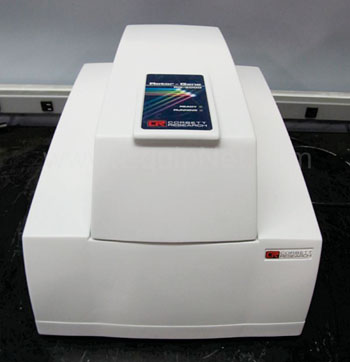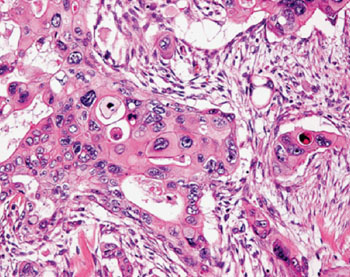Gene Mutation Found for Aggressive Form of Pancreatic Cancer
|
By LabMedica International staff writers Posted on 04 Jun 2014 |

Image: The RotorGene RG-3000 thermal cycler system (Photo courtesy of Corbett Research).

Image: Photomicrograph of pancreatic adenosquamous carcinoma (Photo courtesy of Ralph H Hruban and Noriyoshi Fukushima).
A mutated gene common to adenosquamous carcinoma tumors has been discovered and is the first known unique molecular signature for this rare, but particularly virulent, form of pancreatic cancer.
Pancreatic adenosquamous carcinoma (ASC) is an enigmatic and aggressive tumor that has a worse prognosis and higher metastatic potential than its adenocarcinoma counterpart. There has been little progress in understanding pancreatic ASC, as no mutations unique to this class of pancreatic tumors have been identified.
Scientists at the University of California, San Diego School of Medicine (La Jolla, CA, USA) and an international team evaluated a set of tumors and corresponding normal tissues from 23 patients with ASC of the pancreas, as well as tumors from 24 patients with ductal adenocarcinoma, three patients with solid pseudopapillary neoplasm, two patients with neuroendocrine carcinoma and 21 patients with lung squamous cell carcinoma. Of the 23 ASC patient specimens, there were 19 formalin-fixed, paraffin-embedded (FFPE) tissue sections available. The other four ASC patient specimens were frozen immediately after collection.
Genomic DNA from the frozen samples was extracted using the DNeasy Blood & Tissue Kit (Qiagen; Valencia, CA, USA) and genomic DNA from the FFPE samples was extracted using Qiagen’s QIAamp DNA FFPE Tissue Kit. Quantitative real-time reverse-transcription PCR (RT-qPCR) analysis was performed using the relative quantification method in a RotorGene RG-3000 thermal cycler system (Corbett Research; Mortlake, NSW, Australia).
The investigators found that that ASC pancreatic tumors have somatic or non-heritable mutations in the Up-frameshift 1 (UPF1) gene, which is involved in a highly conserved RNA degradation pathway called nonsense-mediated RNA decay or NMD. It is the first known example of genetic alterations in an NMD gene in human tumors. NMD has two major roles. First, it is a quality control mechanism used by cells to eliminate faulty messenger RNA (mRNA). Second, it degrades a specific group of normal mRNAs, including those encoding proteins promoting cell growth, cell migration and cell survival.
Miles F. Wilkinson, PhD, co-senior author, said, “There has been little progress in understanding pancreatic ASC since these aggressive tumors were first described more than a century ago. One problem has been identifying mutations unique to this class of tumors.” The study was published on May 25, 2014, in the journal Nature Medicine.
Related Links:
University of California, San Diego School of Medicine
Qiagen
Corbett Research
Pancreatic adenosquamous carcinoma (ASC) is an enigmatic and aggressive tumor that has a worse prognosis and higher metastatic potential than its adenocarcinoma counterpart. There has been little progress in understanding pancreatic ASC, as no mutations unique to this class of pancreatic tumors have been identified.
Scientists at the University of California, San Diego School of Medicine (La Jolla, CA, USA) and an international team evaluated a set of tumors and corresponding normal tissues from 23 patients with ASC of the pancreas, as well as tumors from 24 patients with ductal adenocarcinoma, three patients with solid pseudopapillary neoplasm, two patients with neuroendocrine carcinoma and 21 patients with lung squamous cell carcinoma. Of the 23 ASC patient specimens, there were 19 formalin-fixed, paraffin-embedded (FFPE) tissue sections available. The other four ASC patient specimens were frozen immediately after collection.
Genomic DNA from the frozen samples was extracted using the DNeasy Blood & Tissue Kit (Qiagen; Valencia, CA, USA) and genomic DNA from the FFPE samples was extracted using Qiagen’s QIAamp DNA FFPE Tissue Kit. Quantitative real-time reverse-transcription PCR (RT-qPCR) analysis was performed using the relative quantification method in a RotorGene RG-3000 thermal cycler system (Corbett Research; Mortlake, NSW, Australia).
The investigators found that that ASC pancreatic tumors have somatic or non-heritable mutations in the Up-frameshift 1 (UPF1) gene, which is involved in a highly conserved RNA degradation pathway called nonsense-mediated RNA decay or NMD. It is the first known example of genetic alterations in an NMD gene in human tumors. NMD has two major roles. First, it is a quality control mechanism used by cells to eliminate faulty messenger RNA (mRNA). Second, it degrades a specific group of normal mRNAs, including those encoding proteins promoting cell growth, cell migration and cell survival.
Miles F. Wilkinson, PhD, co-senior author, said, “There has been little progress in understanding pancreatic ASC since these aggressive tumors were first described more than a century ago. One problem has been identifying mutations unique to this class of tumors.” The study was published on May 25, 2014, in the journal Nature Medicine.
Related Links:
University of California, San Diego School of Medicine
Qiagen
Corbett Research
Latest Molecular Diagnostics News
- Urine Test Could Reveal Real Age and Life Span
- Genomic Test Identifies African Americans at Risk for Early Prostate Cancer Recurrence
- Blood Test Could Identify Biomarker Signature of Cerebral Malaria
- World’s First Biomarker Blood Test to Assess MS Progression
- Neuron-Derived Extracellular Vesicles Could Improve Alzheimer’s Diagnosis
- Sample Prep Instrument to Empower Decentralized PCR Testing for Tuberculosis
- Endometriosis Blood Test Could Replace Invasive Laparoscopic Diagnosis
- World's First NGS-Based Diagnostic Platform Fully Automates Sample-To-Result Process Within Single Device
- Rapid Diagnostic Breakthrough Simultaneously Detects Resistance and Virulence in Klebsiella Pneumoniae
- DNA Detection Platform Enables Real-Time Molecular Detection
- STI Molecular Test Delivers Rapid POC Results for Treatment Guidance
- Blood Biomarker Improves Early Brain Injury Prognosis After Cardiac Arrest
- Biomarkers Could Identify Patients at High Risk of Severe AKI After Major Surgery
- CLIA Test Identifies Head and Neck Cancer Recurrence from Post-Surgical Lymphatic Fluid
- New 15-Minute Hepatitis C Test Paves Way for Same-Day Treatment
- Ovarian Cancer Assay Outperforms Traditional Tests in Early Detection
Channels
Clinical Chemistry
view channel
Compact Raman Imaging System Detects Subtle Tumor Signals
Accurate cancer diagnosis often depends on labor-intensive tissue staining and expert pathological review, which can delay results and limit access to rapid screening. These conventional methods also make... Read more
Noninvasive Blood-Glucose Monitoring to Replace Finger Pricks for Diabetics
People with diabetes often need to measure their blood glucose multiple times a day, most commonly through finger-prick blood tests or implanted sensors. These methods can be painful, inconvenient, and... Read moreHematology
view channel
MRD Tests Could Predict Survival in Leukemia Patients
Acute myeloid leukemia is an aggressive blood cancer that disrupts normal blood cell production and often relapses even after intensive treatment. Clinicians currently lack early, reliable markers to predict... Read more
Platelet Activity Blood Test in Middle Age Could Identify Early Alzheimer’s Risk
Early detection of Alzheimer’s disease remains one of the biggest unmet needs in neurology, particularly because the biological changes underlying the disorder begin decades before memory symptoms appear.... Read more
Microvesicles Measurement Could Detect Vascular Injury in Sickle Cell Disease Patients
Assessing disease severity in sickle cell disease (SCD) remains challenging, especially when trying to predict hemolysis, vascular injury, and risk of complications such as vaso-occlusive crises.... Read more
ADLM’s New Coagulation Testing Guidance to Improve Care for Patients on Blood Thinners
Direct oral anticoagulants (DOACs) are one of the most common types of blood thinners. Patients take them to prevent a host of complications that could arise from blood clotting, including stroke, deep... Read moreImmunology
view channel
Ultrasensitive Liquid Biopsy Demonstrates Efficacy in Predicting Immunotherapy Response
Immunotherapy has transformed cancer treatment, but only a small proportion of patients experience lasting benefit, with response rates often remaining between 10% and 20%. Clinicians currently lack reliable... Read more
Blood Test Could Identify Colon Cancer Patients to Benefit from NSAIDs
Colon cancer remains a major cause of cancer-related illness, with many patients facing relapse even after surgery and chemotherapy. Up to 40% of people with stage III disease experience recurrence, highlighting... Read moreMicrobiology
view channel
New UTI Diagnosis Method Delivers Antibiotic Resistance Results 24 Hours Earlier
Urinary tract infections affect around 152 million people every year, making them one of the most common bacterial infections worldwide. In routine medical practice, diagnosis often relies on rapid urine... Read more
Breakthroughs in Microbial Analysis to Enhance Disease Prediction
Microorganisms shape human health, ecosystems, and the planet’s climate, yet identifying them and understanding how they are related remains a major scientific challenge. Even with modern DNA sequencing,... Read morePathology
view channel
Genetics and AI Improve Diagnosis of Aortic Stenosis
Aortic stenosis is a progressive narrowing of the aortic valve that restricts blood flow from the heart and can be fatal if left untreated. There are currently no medical therapies that can prevent or... Read more
AI Tool Simultaneously Identifies Genetic Mutations and Disease Type
Interpreting genetic test results remains a major challenge in modern medicine, particularly for rare and complex diseases. While existing tools can indicate whether a genetic mutation is harmful, they... Read more
Rapid Low-Cost Tests Can Prevent Child Deaths from Contaminated Medicinal Syrups
Medicinal syrups contaminated with toxic chemicals have caused the deaths of hundreds of children worldwide, exposing a critical gap in how these products are tested before reaching patients.... Read more
Tumor Signals in Saliva and Blood Enable Non-Invasive Monitoring of Head and Neck Cancer
Head and neck cancers are among the most aggressive malignancies worldwide, with nearly 900,000 new cases diagnosed each year. Monitoring these cancers for recurrence or relapse typically relies on tissue... Read moreTechnology
view channel
Pioneering Blood Test Detects Lung Cancer Using Infrared Imaging
Detecting cancer early and tracking how it responds to treatment remains a major challenge, particularly when cancer cells are present in extremely low numbers in the bloodstream. Circulating tumor cells... Read more
AI Predicts Colorectal Cancer Survival Using Clinical and Molecular Features
Colorectal cancer is one of the most common and deadly cancers worldwide, and accurately predicting patient survival remains a major clinical challenge. Traditional prognostic tools often rely on either... Read moreIndustry
view channel
BD and Penn Institute Collaborate to Advance Immunotherapy through Flow Cytometry
BD (Becton, Dickinson and Company, Franklin Lakes, NJ, USA) has entered into a strategic collaboration with the Institute for Immunology and Immune Health (I3H, Philadelphia, PA, USA) at the University... Read more



















